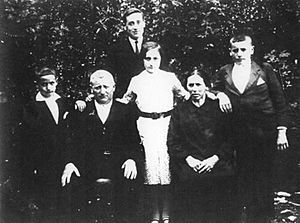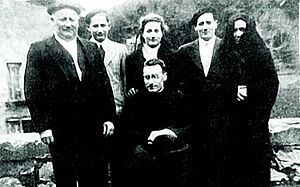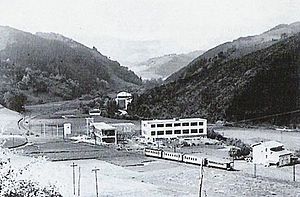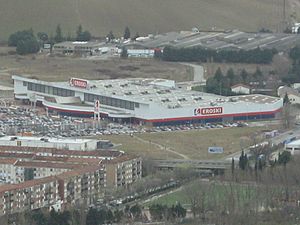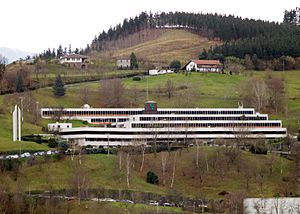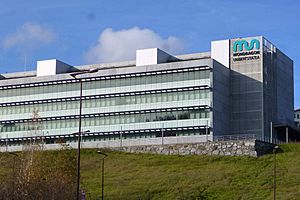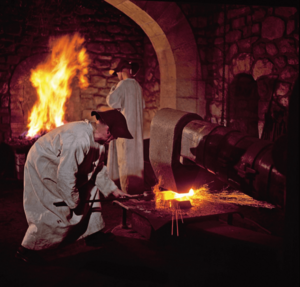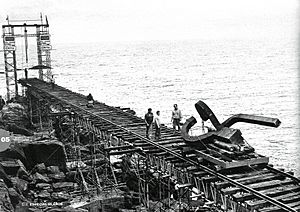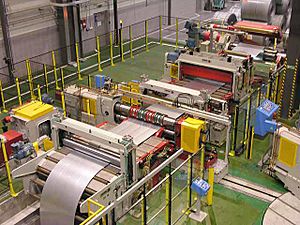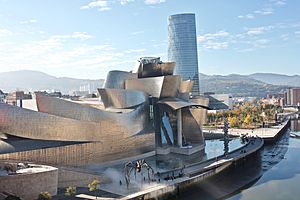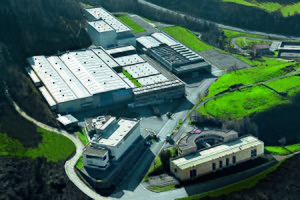José María Arizmendiarrieta facts for kids
Quick facts for kids VenerableJosé María Arizmendiarrieta |
|
|---|---|
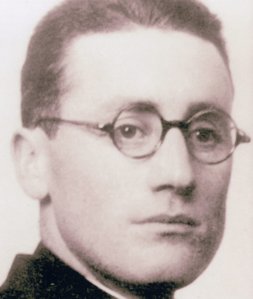 |
|
| Born | 22 April 1915 Markina-Xemein, Biscay Spain |
| Died | 29 November 1976 (aged 61) Arrasate, Gipuzkoa, Spain |
José María Arizmendiarrieta Madariaga (born April 22, 1915, in Markina-Xemein, Bizkaia, Spain – died November 29, 1976, in Mondragon, Gipuzkoa, Spain) was a Basque Catholic priest. He is famous for starting the cooperative companies that grew into the Mondragon Corporation. These companies began in the Basque Country and are now all over the world. By 2021, Mondragon Corporation was the second-largest social economy business group in Spain. It includes many cooperatives, foundations, and businesses in areas like finance, industry, and knowledge.
Arizmendiarrieta was studying to become a priest in Vitoria when the Spanish Civil War started in 1936. He was asked by the Basque Government to work for them. Because he knew the Basque language, he helped edit a new newspaper called Eguna. When Francisco Franco's troops took Bilbao, he was arrested. After the war, he finished his studies and became a priest. In 1941, he was sent to work in the industrial town of Mondragon. He stayed there until he passed away. He was a very practical and hardworking priest. He cared deeply about social justice and human dignity. He helped create many organizations and companies to benefit workers and the community. He called this the "cooperative experience of Mondragon." Today, thousands of people visit Mondragon to learn about his self-managed cooperative model. This model helps create and keep jobs. The Catholic Church recognizes him as Venerable.
Contents
- Who Was José María Arizmendiarrieta?
- Cooperative Companies: 1955-1976
- His Ideas and Actions
- His Impact and Legacy
- See also
Who Was José María Arizmendiarrieta?
His Early Life: 1915-1931
José María Arizmendiarrieta, often called "Arizmendi," was born on April 22, 1915. He grew up in a simple farmhouse called Iturbe in Barinaga, part of Markina-Xemein, Biscay. His parents were José Luis and Tomasa. His father was known as a peaceful and cheerful man. His mother was a smart, organized, and hardworking homemaker. She was in charge of raising her children and managing the farmhouse.
José María was the oldest of four children. When he was three, he had a bad fall and hurt his head. He lost his left eye and had an artificial one. This accident affected his personality. His mother also became very protective of him.
Because of his visual disability and how he was raised, José María was shy and quiet. He was intelligent but not very strong physically. He became a modest and practical person, much like his mother. Even though his mother could not read, she saw his love for books. When he was twelve, she encouraged him to go to the Minor Seminary of Castillo Elejabeitia. There, he started wearing glasses to hide his eye. His desire to become a priest grew stronger. He learned a lot at the seminary but never forgot his simple peasant background. He learned the value of hard work from his mother. He grew up speaking only Basque language. At the seminary, he studied general subjects in Spanish and Latin. Four years later, he moved to the new Diocesan Seminary of Vitoria.
Seminary Days in Vitoria: 1931-1936
Arizmendiarrieta was at the Seminary during the Second Spanish Republic. This was a time when social issues were very important. The students studied philosophy and theology. They also learned about Pope Pius XI's social encyclical, Quadragessimo Anno. He learned a lot from the Priestly Movement of Vitoria. He adopted their motto: "Be a priest, always and in everything a priest." They valued austerity, punctuality, silence, hard work, and good hygiene.
There were two groups of students at the Seminary. One group was younger and played sports like football. The other group was more serious. They thought about world problems like peace, war, and social issues such as hunger. Arizmendiarrieta belonged to this serious group. One of his influential teachers was Manuel Lekuona. He believed priests should help cultivate the Basque language. In 1933, Arizmendiarrieta and other students founded the "Third level of the Kardaberaz Society." Their motto was "Always forward." Arizmendiarrieta wrote their rules and founding statement. He also became the deputy director, managing the group's activities.
Teachers like Lekuona taught students to observe critically, not just study. Arizmendiarrieta felt that focusing too much on "temptations of the world" made them unaware of real temptations: power and comfort.
Civil War and Becoming a Priest: 1936-1941
When the civil war began in July 1936, Arizmendiarrieta was on vacation at his family farmhouse. The new Basque Government asked him to join their efforts. A military doctor said he was not fit for active military service. So, he was assigned to help edit the newspaper Eguna (The Day). This newspaper was in Basque and helped the government talk to Basque speakers. He also wrote for Gudari (Soldier), a bilingual newspaper for Basque militias. His articles supported anti-fascist, nationalist, and Christian-Democratic ideas. He wrote about social justice. Some of his friends from the Vitoria seminary also worked with him.
In June 1937, rebel troops took Bilbao. Arizmendiarrieta tried to escape to France. But he worried about his family, so he went back home. He was arrested because he wrote for Eguna and Gudari. After a quick trial, he was one of four people saved from being shot. He said he was a soldier, not a journalist. He was released without charges. Then, the Francoist army made him join their forces. He was sent to an artillery regiment in Burgos. He got permission to keep studying theology at the seminary there. Later, he moved to the Bergara seminary.
In September 1939, he returned to the Vitoria Seminary. His professor, Rufino Aldabalde, believed that after the war, social issues were crucial for new priests. Arizmendiarrieta became director of a group's newsletter called "Pax". In March 1940, it changed its name to "Arises". This led to the Priestly Movement of Vitoria. Arizmendiarrieta focused on social work, especially with young people and workers.
On January 1, 1941, he celebrated his first mass in Barinaga. His parents and relatives were there. He wanted to study sociology in Belgium. However, he was assigned as an assistant curate to the parish in Mondragon. This town, 30 miles from his home, had high unemployment and social tensions after the civil war.
His Work in Mondragon: 1941-1954
He arrived in Arrasate (Mondragon) in February 1941. He was a 26-year-old new priest. For centuries, Mondragon was known for working with iron in its forges and craft workshops. By the early 20th century, it had busy industrial activity. Companies made laminates, sheet metal, screws, locksmiths, household appliances, and office furniture. When he arrived, these companies employed 1,500 workers out of 8,800 people.
The biggest company was the Locksmith Union, with 800 employees. It had its own School of Apprentices. Arizmendiarrieta started teaching social training there for one hour a week. This connection with young apprentices led him to restart Catholic Action. It became a place for social, cultural, and religious activities. In 1942, he added new groups like Sports Youth and a Sociology Academy. He also created the Hallelujah magazine for new recruits. He focused on vocational training to help the community. He wanted to share knowledge and training with all workers' children. But the Locksmith Union management did not support his ideas to expand their school.
Arizmendiarrieta visited a Professional School in Vitoria. He decided to create his own school in Mondragon. In 1943, he opened a Professional School under Catholic Action. It was built with donations. This was a private school, not a cooperative. Students worked for four hours in the morning and went to class for six hours in the afternoon.
In 1945, Arizmendiarrieta helped build the Iturripe stadium. Businesses and the community helped pay for it. He wrote the rules for the stadium, making it a municipal sports society.
In 1946, Arizmendiarrieta took training to a new level. He chose the best eleven young people who finished their vocational studies. They studied Industrial Engineering on their own, but were enrolled at the University of Zaragoza. They worked 55 hours a week at the Locksmith Union. At night, they studied with teachers from the Professional School. All of them passed their exams. Five of these students later started ULGOR, the first cooperative, in 1956. Also in 1946, he helped create a clinic for tuberculosis in Mondragon.
The years after 1947 were difficult socially. Workers demanded better wage claims. Arizmendiarrieta supported them by helping write their requests. He still kept good relationships with business owners. They helped him create the League of Education and Culture foundation. But over time, there were conflicts between the Locksmith Union's leaders and the engineering students.
In 1952, the new Zaldispe Professional School, started by Arizmendiarrieta, opened. He stayed in the audience, while important people like the Minister of Education and the Bishop were on stage. The first class of Industrial Engineers received their degrees. In August 1953, he started a new housing complex for workers. He created the "Mondragon Home Association" to build these homes. Arizmendiarrieta lived a simple life. He did not take a salary. He traveled by train or in friends' cars. In Mondragon, he rode his bicycle, just like the workers.
Illness and Passing: 1963-1976
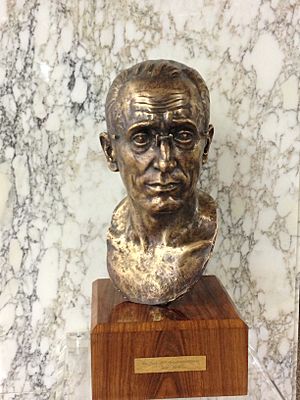
In 1963, Arizmendiarrieta started having small health problems. This was likely due to his very busy life. He was a priest, teacher, speaker, and attended many meetings. He visited workplaces and traveled a lot. He also read constantly. He never fully recovered. In February 1967, he had a cardiac embolism. He had surgery in Madrid to get an artificial heart prosthesis.
After a few normal years, he was hospitalized in Bilbao in January 1973 for heart issues. He had to follow a strict recovery plan. He returned to Mondragon feeling weak. His illness was irreversible. In February 1974, he had another surgery because his artificial valve needed to be replaced. The operation went well, but his wounds became infected and did not heal. This was called the "sickness of the operating room." In April, he went home to Mondragon, where his wounds were treated daily. He quietly endured this physical suffering. Even though he was weak, he tried to live a normal life. After more hospital stays, he was admitted to the Mondragon Health Center in November 1976. Doctors decided not to make him suffer more with treatments. He passed away on November 29.
His body was in the parish church for two days. Thousands of people came to honor him. On December 1, his funeral was held. The Minister of Labor and 60 priests attended.
Cooperative Companies: 1955-1976
Before 1955, Arizmendiarrieta worked in four main areas. He always focused on cooperation among different groups of people:
- Parish church: This included the Catholic Action Center and spiritual activities.
- Social work: He helped with health care and built housing for workers.
- Education: This was mainly through the Professional School.
- Recreation: He supported sports and cinema for young people.
He still wanted to involve workers in owning and managing companies. After 13 years of helping with social and training projects, Arizmendiarrieta focused on creating social enterprises. He called this the "cooperative experience."
How Cooperatives Were Organized

Arizmendiarrieta created an open system where everyone could participate. It did not matter their race, belief, social class, or gender. All cooperatives had some common rules:
- The General Assembly of members was where decisions were made. Each person had one vote, no matter how long they had been there or how much money they had invested.
- The Assembly elected the Governing Council, which was like a board of directors. Anyone could run for election.
- The Governing Council chose the Managing Director, who then picked their own management team.
- Workers also elected members to the Social Council, which was like a workers union.
The members of each cooperative changed depending on its type:
- Industrial cooperatives: Only their workers were members.
- Credit and research cooperatives: Workers and companies were members.
- Consumer cooperatives: Workers, companies, and customers were user members.
- Training cooperatives: Workers, companies, and students were members.
All cooperatives were private and self-managed. They offered services to the public. Research and training cooperatives were non-profit.
Consumer Cooperatives
In July 1955, the houses built by the "Mondragon Home Association" were finished. Arizmendiarrieta then helped neighbors create the San José Consumer Cooperative. This cooperative offered a community alternative to the company stores, like the one at the Locksmith Union. He organized everything himself. He found founding members, gathered documents, and learned about the cooperative business model. He found a store location and wrote the company's rules. He was included on the Governing Board. To pay for the store, Arizmendiarrieta arranged interest-free loans from companies. In return, the companies could use the cooperative as their own store.
The San Jose Consumer Cooperative also created jobs, mostly for women. Arizmendiarrieta wanted to help women become independent. He expanded a teaching section in the Professional School for the 400 single female workers in Mondragon. Over time, more consumer cooperatives were created. In September 1969, several cooperatives merged to form the new Eroski Group.
Industrial Cooperatives
By early 1955, Arizmendiarrieta stopped trying to make the Locksmith Union involve its workers in ownership and management. Instead, he encouraged five close friends to start a new company called ULGOR. The name came from the first letters of their names: Luis Usatorre, Jesus Larrañaga, Alfonso Gorroñogoitia, Jose Maria Ormaetxea, and Javier Ortubay. They needed permission from the government in Madrid. When they were refused, they bought a struggling company in Vitoria in October. This company had a license to make "appliances for domestic use," like cooking oil stoves.
In April 1956, Arizmendiarrieta blessed the building where ULGOR was located in Mondragon. They continued making the old stoves and started a new oil stove, copied from an English model. They also got a license to make selenium plates from a German company.
Arizmendiarrieta trusted talented young people from the School. He believed that "to create cooperatives you have to train cooperative members." New businesses were chosen carefully. They did not exist in the Alto Deba Valley already, so they would not compete with existing companies. Also, they were related to the founders' skills from the Locksmith Union and the Professional School. For example, Usatorre and Larrañaga handled electrical appliances, Ormaetxea managed the foundry, and Gorroñogoitia focused on electronics. In August, they moved machinery from Vitoria to Mondragon. The workshop officially opened in November.
After ULGOR's success, Arizmendiarrieta helped create Talleres Arrasate Industrial Cooperative in Mondragon in 1957. This cooperative helped save the bankrupt Aranzabal Workshop. Arizmendiarrieta wrote the rules for this new cooperative. It focused on making and selling machines, tools, and punching equipment.
Credit Unions
In August 1958, Arizmendiarrieta visited the World Exhibition in Brussels. He also visited companies in France, Holland, Belgium, and Germany. After this trip, he decided to create cooperative credit organizations. In early 1959, he wrote plans for a financial organization and a support organization.
Financial Support
The "Labour Bank" (Laboral Kutxa) was a credit cooperative. Its goal was to help industrial and service cooperatives with their investments and growth. It also managed their profits and members' savings. The first office opened in October 1959. Besides its financial role, it also provided Social Welfare services for the 314 members of ULGOR and Talleres Arrasate.
Arizmendiarrieta made sure that existing cooperatives became members of the credit cooperative. This helped them all become stronger. From the beginning, Labour Bank had two parts: the Financial Division and the Business Division. The Financial Division acted like a regular savings bank. The Business Division helped existing cooperatives with things like international business and legal advice. It also helped create new cooperatives in different areas like research, farming, and education.
Arizmendiarrieta wanted everyone to get involved. He used simple messages. In 1960, at the opening of a new Labour Bank office, his motto was "O notebook, o suitcase". This meant: save to invest and create jobs, or you might have to leave to find work.
Mutual Assistance
In June 1959, the EPSV-Voluntary Social Welfare Entity called Lagun Aro was created. It helped cooperative members with social protection. As self-employed workers, they were not covered by the public social security system.
Lagun Aro provided a mixed system of coverage. It included benefits from the Public Social Security System and its own benefits. These included coverage for illness, unemployment (if a cooperative had problems), retirement, widowhood, and extra health care. Like Laboral Kutxa, cooperatives were members of Lagun Aro.
Farming Cooperatives
Arizmendiarrieta came from a farming family. He believed that social development needed the primary sector (farming, fishing, forestry). After the first industrial cooperative, he started the LANA cooperative. This cooperative included livestock, agricultural, and forestry sectors in the Alto Deba Valley. It was a mixed cooperative with two types of members: village producers and workers of the processing cooperative. Over time, LANA grew and specialized into three parts: dairy, livestock, and forestry.
Cooperative University
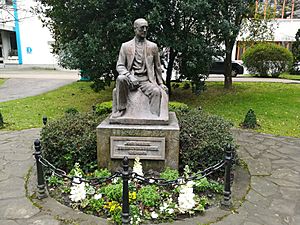
In early 1961, Arizmendiarrieta started planning a new Professional School. It would have a higher academic level and centers in Mondragon, Bergara, and Oñati. He believed that well-trained students and teachers were essential for industrial cooperatives to grow. He wanted the school to be close to the best European research and development levels. This would help companies work with the school.
In 1963, construction began on the new Professional School in Iturripe. It was designed for 1,500 students. It would offer studies up to Technical Engineering. It officially opened in 1967. A special feature was that the School's members included cooperative and non-cooperative companies, teachers, and students. All three groups had a say in the Assembly and Governing Council.
He also developed the MEDUO University Project in 1965. He wanted to create a "popular and social" university. It would focus on equal educational opportunities. It would also promote lifelong learning. This project was very ambitious for its time. The current Mondragon University was finally established in 1997.
County Cooperative Group
In 1961, Arizmendiarrieta wrote about cooperation within and between cooperatives. He saw it as a way to achieve personal and group success. He suggested a way to build up capital and grow through industrial concentration.
The leaders of ULGOR developed this idea. This led to the creation of Ularco, a group of industrial cooperatives in the Alto Deba Valley. It included ULGOR, Arrasate, Copreci, and Ederlan. This was a union of cooperatives, similar to groups of capitalist companies. But in Ularco, power came from a shared agreement, not just from capital. One of Arizmendiarrieta's biggest achievements with the Group in 1964 was sharing profits among all members. For example, when ULGOR made 30% profit, Ederlan only made 3%. The new group aimed to ensure "the needs of a modern company with proper technical, financial, and commercial development."
Student's Industrial Cooperative
Arizmendiarrieta also created an industrial cooperative for students of the Professional School. This had two goals. First, it helped students with limited money pay for their studies. Second, it provided dual training. Students had theoretical classes at school and practical work experience in a real company.
In November 1965, he started the process to officially recognize Alecoop (Cooperative School Labor Activity). It became official in April 1966. The company made and sold auxiliary tools for mechanical workshops and electrical installations. Students worked half a day in the cooperative, which fit with their school schedule.
Women's Industrial Cooperative
In all cooperatives, women had equal rights to men. But in the mid-1960s, Arizmendiarrieta became more concerned about women's work emancipation. At that time, women often stopped working after marriage. In cooperatives, the link was a "partnership contract," not a regular work contract. So, single women members' contracts ended when they got married. Arizmendiarrieta felt marriage was almost like "exile" for women, separating them from social life.
To improve this, he helped build a female pavilion at the School for classrooms and laboratories. This allowed young women to study chemistry and electronics. He also helped create a women's industrial cooperative. In November 1967, he founded the Auzo Lagun company. This company provides catering services for schools, companies, residences, and hospitals.
Cooperative Research Center
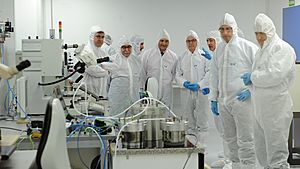
Arizmendiarrieta knew that buying patents from other countries meant relying on their technology. He saw how companies, universities, and research centers worked together abroad. In 1965, he started talking about the importance of research and technology in his weekly talks at the Professional School. He believed that competition between nations was about companies working with laboratories. So, it was important to invest in people and technology. He convinced professors at the School to do applied technological research. In 1968, a team was created with some independence from the School.
He encouraged cooperatives in the Alto Deba Valley to hire the research team for projects. Laboral Kutxa helped fund a separate building for research. The goal was to have their own research capabilities, like the German Fraunhofers. This research center would eventually become the first cooperative company for applied research. In 1973, Laboral Kutxa approved the project. Construction began in October 1974. The research center, Ikerlan, became its own cooperative in 1982. Arizmendiarrieta also involved the Public Administration in funding projects. This inspired public-private collaboration in research in the Basque Country.
Cooperative Corporation
In February 1966, Arizmendiarrieta visited laboratories and factories in France. In September, he toured Germany, visiting different types of cooperatives. He returned with the idea that Mondragon could also achieve similar development. This meant becoming competitive in larger areas, which reinforced his message of cooperation.
Cooperatives were grouped into Regional Groups like Ularco based on their location. In December 1984, the Mondragon Cooperative Group was created. This group had a more business focus. The process ended with the first two Congresses in 1987 and 1989. They approved the main ideas of what is now the Mondragon Corporation.
His Ideas and Actions
What Influenced Him?
Arizmendiarrieta wanted social justice and human dignity. He was not just a dreamer. He had a lot of historical, business, and ideological knowledge. He spent many years observing and reading. His special skill was being practical. He knew how to turn his ideas into real creations.
Historical Background
Arizmendiarrieta knew about the history of cooperation in the Basque Country. People there had a long tradition of cooperation, known as “Auzolan” (Community work). This was free work done by neighbors for the benefit of everyone. They would decide together where, how, and who would do the work. This included building roads, churches, or helping a neighbor in need.
In the 20th century, the first consumer cooperative was created in Bilbao in 1919. These cooperatives followed the principles of the Rochdale Society of Equitable Pioneers, founded in 1844 in England. In 1933, a union agreed to strengthen the cooperative movement. This led to the creation of the first production and credit cooperatives.
Also, in 1920, a socialist union helped workers in struggling companies create the ALFA cooperative in Eibar. It started by making weapons and later sewing machines. It was the largest industrial cooperative of its time. Arizmendiarrieta admired its managing director, Toribio Echevarria.
Business Environment
The Deba Valley, where Mondragon is located, has been linked to forges and metallurgy since the thirteenth century. In the 15th century, many people in Mondragon made steel billets. They sold these for making weapons or turned them into nails and ironwork. Forges used water power to operate machinery. This continued until the Industrial Revolution in the 19th century, when blast furnaces were introduced.
When Arizmendiarrieta arrived in Mondragon in 1941, after the war, the town was struggling. The largest company was “Locksmith S.A.”, created in 1906. It had 850 employees and was listed on the Stock Exchange. It was a major force for other smaller locksmith companies. By mid-1948, it had 2,000 workers. The second largest company was “Modern Locksmith ELMA,” with over 300 employees.
Many small industrial companies existed in the Deba Valley. Two medium-sized ones were "La Algodonera San Antonio, S.A." in Bergara, which made textiles, and "Hijos de Juan de Garay, S.A." in Oñati, which made welded steel tubes.
His Beliefs
Arizmendiarrieta had a small, simple office at the Professional School. He was an avid reader of many different topics. He read books from the Labour Party, and by Catholic thinkers like Hans Küng and Jacques Maritain. He also read the communist manifesto by Marx and Engels.
His own ideas combined classical and social-Catholic teachings from the Seminary with new socialist and personalist theories. He sought a religious solution to social problems. He bought books by thinkers who could influence society and gave copies to his students.
Reading was very important to him. He underlined interesting ideas in his hundreds of books. He carefully wrote his thoughts on "pedestrian humanism" in over 10,000 files. After being held during the civil war, he only wrote in Spanish for a while. In August 1968, he started writing in Basque again for the magazine TU Lankide.
Living Simply
Arizmendiarrieta lived a very simple life. When he was young, it was out of necessity. Later, it was by choice. He lived on the small salary of a curate. He never took money from the cooperatives or organizations he helped create. He worked in a small office at the Professional School. He ate and drank very little. In Mondragon, he rode his bicycle like the workers. Later, cooperative leaders "stole" it and gave him a velosolex (a bicycle with a small motor). For trips outside Mondragon, he asked friends for rides or bought the cheapest tickets.
Even though he started many cooperatives and often wrote their plans, he never held an official position. When he received individual awards, he always shared the credit with those who helped him.
He never acted for his own benefit. Some business owners in Mondragon did not like his ideas. They were suspicious of workers participating in company ownership and management. But Arizmendiarrieta stuck to his belief in social justice. In 1956, the Civil Governor threatened to move him. He replied that he would obey his bishop, but he would not become a priest who just went along with things.
Being Approachable
Arizmendiarrieta turned his ideas into real projects by working with many people. He worked with politicians, business owners, teachers, and young people. He did this with empathy and respect for everyone. He avoided seeking praise or power. When he was young, he rode his bicycle to be like the workers. He ate simply. When important officials from Madrid visited, Arizmendiarrieta would ask the nuns to prepare hot broth for them.
In 1958, Guillermo Reyna, the Director of Professional Education in Madrid, visited Mondragon. He was surprised that students did not stand up or show deference to Arizmendiarrieta. Arizmendiarrieta apologized and explained, "I don't allow them to treat me as a Director, because I am at the School as one more. It has been a procedure that has given me good results so far." In fact, Arizmendiarrieta was never officially listed as Director.
In 1965, the Minister of Labor came to give him a gold medal for Merit at Work. The President of the Mondragon Education League spoke about Arizmendiarrieta's desire to keep his work separate from personal gain. He said, "He is still as poor as when he arrived 25 years ago, and just like then, his mother continues to send him beans and potatoes from the farmhouse." He added, "He has created a mentality, a way of doing things. He has been turned to for everything, and he always has a free moment, a word of encouragement, an idea to solve a problem." Arizmendiarrieta's reply was typical. He said he had no merit. He always spoke in the plural, giving credit to the hundreds of people who worked with him.
Years of Preparation
When Arizmendiarrieta arrived in Mondragon in 1941, it took 15 years of preparation before the first industrial cooperative, ULGOR, began. This period started with the creation of the Professional School in 1943. This school allowed all workers' children to study, unlike the Locksmith Union Apprentice School. Arizmendiarrieta did not yet have a clear cooperative model. But he knew that workers could only become independent through education and their own work. So, he encouraged responsibility and cooperation.
He also organized a library for young people and study groups for older people. In June 1943, he founded a Social or Sociology Academy. The goal of these meetings was to "train future worker leaders." Besides teaching at the Professional School, Arizmendiarrieta led over two thousand study groups. Some were for religious and human development, others for social formation. This means he gave a talk almost every 2.7 days for 15 years!
The Professional School was his favorite place for his Catholic and social work. Every day at 2 PM, he gave a 20-minute talk to professors and students. He spoke about many topics, like Russian peasant cooperatives, Yugoslav self-management, or German co-management. His talks were sometimes hard to understand because of his monotone voice and complex language. He knew this, so he used short, memorable quotes like “knowledge is power” or “it is easier to educate a young person than to reform a man.”
He also used short quotes in his daily mass sermons. Once, parishioners asked the bishop to replace him because they did not understand him. But the bishop refused, valuing his social work more. In July 1967, he was invited to speak in Madrid about the future of Spanish cooperativism. His speech was difficult for the audience to follow. The director explained, "Keep in mind that Father Arizmendiarrieta thinks in Basque, and translates it into Spanish."
Learning and Working
Arizmendiarrieta influenced his collaborators by leading through example. His own resume, written by him, shows his dedication to studies. He studied "Philosophy and Theology" at the Seminary of Vitoria. He also took special intensive courses in "Ethical-Social" at the University of Comillas and "Economics" at the Social School of Vitoria.
He stayed in close contact with the Vitoria Seminary. He attended courses at the Social School every year. He was interested in economics, sociology, philosophy, and education. He saw his role as a chaplain as an encourager and, most importantly, an educator. He worked hard to convince young people about the importance of training. He often repeated quotes like "Man is made through training" or "It is better to light a match than to curse the darkness."
Arizmendiarrieta often wrote about the benefits of investing in education. He emphasized that the community was responsible for education. This came from his own experience that the State's help was not enough. He also believed that society should manage its own problems. But he supported dual training, where students also worked. This way, the community did not bear the full cost of studies. He also thought that studying and working should be combined throughout life, not just separate stages. Young people should combine study and work, and adults should also have the right and duty to combine work and study.
Work and Unity
In September 1960, Arizmendiarrieta created the cooperative magazine "TU-Work and Union." He always directed it. He said that “Work is the strong base for development, the Union multiplies everyone's strength, and Cooperation is a system of solidarity.” He made sure these ideas were in the cooperatives' Statutes.
He saw the magazine as an invitation to talk and cooperate. It aimed to apply social justice in business, in a spirit of freedom and love. He believed work helped people grow personally and as a group. It showed a strong humanistic and social conscience.
He constantly explained that work gives people dignity. He noted that a study showed that in the United States, nature contributed only one-eighth to development, while labor contributed seven-eighths. The Deba Valley, where Mondragon is, does not have many natural resources. Its development comes from the hard work of its people.
He saw unity as a sign of solidarity in a democracy. Cooperatives should be democratic, with each member having one vote. Unity also required everyone's responsibility. Unity is the strength of the weak, and solidarity is a powerful tool.
Changing the Company
Arizmendiarrieta wanted to improve workers' dignity by changing how companies operated. He was inspired by Christian Social teachings. As early as 1933, a Basque trade union said that workers' rights were not just about fair wages. They demanded workers' participation in the company, sharing profits, and co-managing the company. After the Civil War of 1936, unions were banned. But Christian Social ideas continued in Catholic worker groups. In the 1960s, Catholic labor movements in Germany and Belgium strongly demanded workers' access to company management, profits, and shareholding. They criticized how capital was more important than people.
After 15 years of trying to change the Locksmith Union without success, Arizmendiarrieta made a big decision in 1956. He encouraged a group of skilled young people to leave their secure jobs at the Locksmith Union. He wanted them to create a cooperative. He aimed to put his ideas into practice: that work is more important than capital, that workers should manage themselves, and that companies should be democratic. Of course, Arizmendiarrieta's relationships with some employers got worse. There were even problems with the Professional School, where they had worked well together before. After the cooperatives started succeeding, he wrote that one of the most important tasks was to help people realize their own abilities. Workers needed to feel hope for true emancipation through work and Christian peace. From then on, he stopped talking directly about changing existing companies.
Leadership and Influence
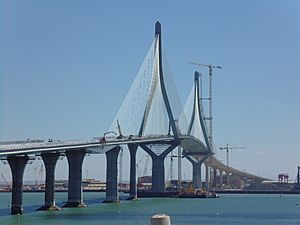
Arizmendiarrieta's way of working was to team up with young people he trusted. His teaching at the first Professional School and his work with Sports Youth and Catholic Action helped him find the most dedicated young people. In 1946, he chose eleven young people to study Industrial Engineering on their own. In 1955, five of them, who were already good professionals at the Locksmith Union, were encouraged to create the first industrial cooperative, ULGOR. His successes from 1941 to 1955 gave young people enough confidence to leave secure jobs. Even though they were newlyweds and paying mortgages, they started a new adventure, trusting their mentor.
By 1959, ULGOR was growing successfully. The members had elected Alfonso Gorroñogoitia as president. The Council had appointed José María Ormaetxea as managing director. But Arizmendiarrieta wanted to create a cooperative credit organization. After writing the plan and rules for the Labour Bank, he got government approval. To manage it, he looked for honest people. He asked Ormaetxea to be its director. Ormaetxea went from managing a big company to a small office. Ormaetxea said, "I accepted, despite being completely unaware of the banking business, and barely knowing how to interpret a balance sheet". Arizmendiarrieta also convinced Gorroñogoitia to be president of both ULGOR and the Labour Bank.
In 1965, Arizmendiarrieta personally started the Alecop student industrial cooperative. To pay for its facilities, he asked for subsidies from public bodies and a loan from the Labour Bank. The bank needed guarantors. Arizmendiarrieta asked several professors from the Professional School to sign. One of them, Manolo Quevedo, who later founded the Ikerlan Research Center, said, "I replied that I would sign, but after obtaining the approval of my wife, because we already had three small daughters. Endorsing a company in which the partners and managers were going to be the students, and the guarantors would not have any connection, was certainly unusual."
His Impact and Legacy
- In 1952, after the new Professional School opened, he received the Commendation of the Civil Order of Alfonso X el Sabio from the Minister of Education.
- In April 1966, Mondragon honored three important people, including Arizmendiarrieta, by naming them adoptive sons of the town. All three were celebrating 25 years of work in Mondragon.
- In August 1966, after the Alecoop student industrial cooperative opened, the Minister of Labor personally gave him the gold medal for Work.
- The Olandixo hillside road, opened in 1972, where Lagun Aro, Ikerlan, and Laboral Kutxa are located, is named Paseo Jose Maria Arizmendiarrieta.
- In 1992, a monument was built in his honor in his hometown of Barinaga, in Markina-Xemein.
- In 1997, Arizmendi Bakery opened in San Francisco, California, named after Arizmendiarrieta.
- On May 6, 2009, the local process for his canonization (becoming a saint) finished.
- On December 14, 2015, Pope Francis declared Arizmendiarrieta to have "heroic virtue," making him Venerable in the Catholic Church.
- In April 2016, Laubide Square in Mondragon was renamed Square Jose Maria Arizmendiarrieta. A plaque there reads: “Square Jose Maria Arizmendiarrieta (1915-1976). Founder of the Arrasate-Mondragon cooperativism. Associated work model that extends universally. 100 years after his birth.”
See also
- In Spanish: José María Arizmendiarrieta para niños
- 127 photos of Arizmendiarrieta
- Mondragon Corporation
- Rochdale Society of Equitable Pioneers
- ICA-International Cooperative Alliance


